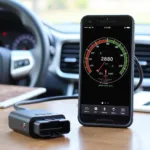The automotive world is rapidly evolving, and staying ahead of the curve requires embracing new technologies. One such technology that has gained immense popularity among car enthusiasts, students, and professionals alike is the Arduino OBD2 car simulator. This guide delves into the world of Arduino OBD2 car simulators, exploring their functionalities, benefits, and applications.
What is an Arduino OBD2 Car Simulator?
An Arduino OBD2 car simulator is essentially a device that replicates the On-board Diagnostics II (OBD2) system found in modern vehicles. It utilizes the versatility of the Arduino platform, an open-source electronics platform based on easy-to-use hardware and software, to simulate various car sensor readings and communicate them via the OBD2 protocol.
In simpler terms, imagine having a miniature version of your car’s computer system that you can control and manipulate. This allows you to generate specific data from virtual sensors, such as engine speed, coolant temperature, throttle position, and more, without needing an actual running vehicle.
Why Use an Arduino OBD2 Car Simulator?
The applications of an Arduino OBD2 car simulator are vast and cater to a wide range of users:
-
Educational Purposes: For automotive students and hobbyists, it serves as a valuable tool for understanding the intricacies of car electronics and the OBD2 communication protocol. They can experiment with different sensor readings and analyze their effects on diagnostic trouble codes (DTCs) and other parameters.
-
Testing and Development: Automotive engineers and developers can leverage this technology to test OBD2 scanners, diagnostic software, and other automotive electronics without requiring a physical vehicle, saving both time and resources.
-
Troubleshooting and Diagnostics: Mechanics and DIY enthusiasts can use the simulator to recreate specific fault conditions, aiding in the diagnosis and repair of real-world car problems.
Building Your Own Arduino OBD2 Car Simulator
Creating your own Arduino OBD2 car simulator is an exciting and rewarding project. Here’s a step-by-step guide:
-
Gather the Components: You’ll need an Arduino board (such as Arduino Uno), an OBD2 connector, jumper wires, a breadboard (optional), and various sensors depending on your desired simulations (e.g., temperature sensor, potentiometer for throttle position).
-
Connect the Hardware: Connect the OBD2 connector to the Arduino board using the appropriate pins. Depending on your sensor choices, connect them to the Arduino’s analog or digital input pins.
-
Write the Arduino Code: Utilize the Arduino IDE to write code that simulates sensor readings and transmits them through the OBD2 protocol. You can find numerous code examples and libraries online to get started.
-
Test and Calibrate: Once the code is uploaded, connect the simulator to an OBD2 scanner or software and verify if the simulated data is being received correctly. Adjust sensor readings and code parameters to achieve desired simulation accuracy.
Advantages of Using an Arduino OBD2 Car Simulator
-
Cost-Effectiveness: Compared to purchasing expensive automotive testing equipment, building an Arduino-based simulator is significantly more affordable, making it accessible to a broader audience.
-
Flexibility and Customization: The open-source nature of Arduino allows for limitless customization. You can tailor the simulator to your specific needs by incorporating different sensors and modifying the code to simulate a wide array of scenarios.
-
Safe Learning Environment: Experimenting with real car systems can be risky, especially for beginners. The simulator provides a safe and controlled environment to learn and troubleshoot without the fear of damaging an actual vehicle.
Conclusion
The Arduino OBD2 car simulator has emerged as a valuable tool in the automotive world. Its ability to replicate real-world car systems in a controlled and customizable environment makes it an indispensable asset for education, development, and diagnostics. As technology continues to advance, we can expect to see even more innovative applications of Arduino OBD2 simulators in the future, further shaping the landscape of automotive electronics.


